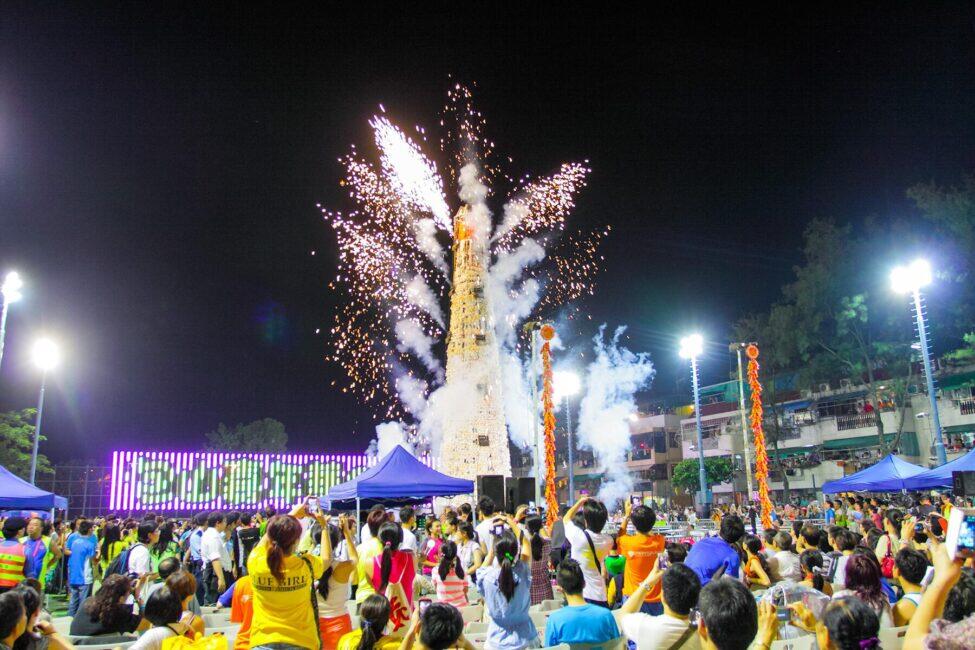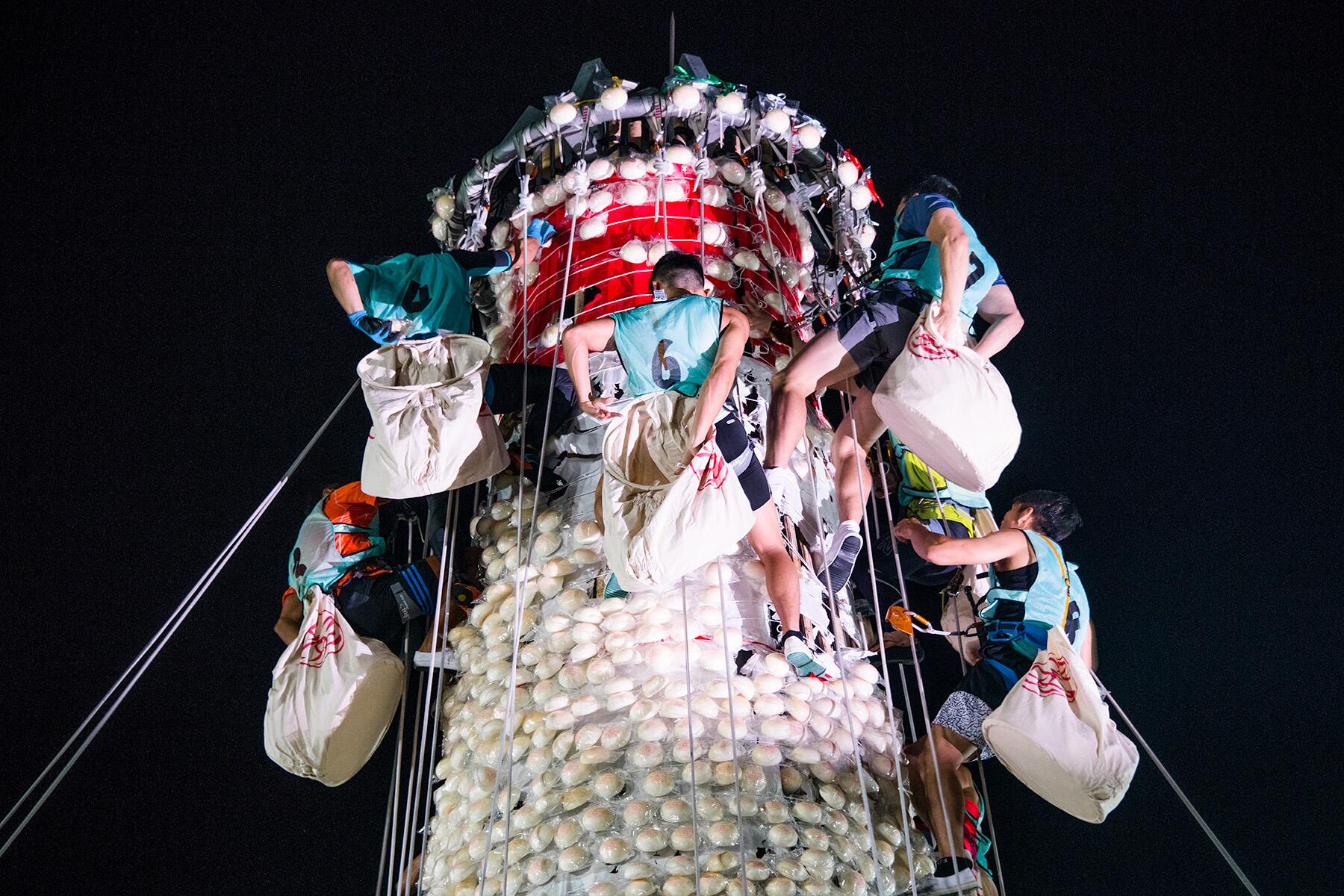Fluffy white steamed buns are abundant on Hong Kong’s busy streets, but on a quiet island, you’ll find a unique festival unfolding.
Hong Kong has more than 200 islands, with Cheung Chau just 40 minutes southwest by ferry from the city’s Central pier. This quiet, laid-back stretch of land is covered in jungle, sandy beaches, and a thriving waterfront with seafood restaurants, souvenir shops, hundreds of colorful boats, and, surprisingly, even a McDonald’s. The island is popular with locals and tourists for its easy hiking and great food—it’s the perfect day trip to escape from the skyscraper-packed mainland.
Towards the north of the island lies Pak Tai, an 18th-century temple named after the Taoist god of the sea, which is intricately decorated with colorful ceramic tiling and is the location of Cheung Chau’s annual Bun Festival. An eclectic mix of parades, dancing, and more buns than a small island of 22,000 people could possibly eat. The festival has returned this spring after a three-year break due to the pandemic.
Pirates, Plagues, and Ping On
The festival’s history is like something from a storybook. In the 18th century, the island suffered dreadful plagues, followed by a terrifying pirate invasion. The local fishermen eventually drove out both using an image of their deity, Pak Tai, whose likeness was paraded through the village streets. To celebrate being rid of disease and swash-buckling invaders, the island held its very first bun festival, which is now officially part of China’s Intangible Cultural Heritage. The yearly festival’s main celebration occurs on the eighth day of the fourth Lunar month each year, which is also the Buddha’s birthday. It lasts four days, culminating in the nail-biting bun scrambling competition, although there are often events and activities throughout the month. In 2023, there are a variety of kids’ activities such as races, games, entertainment, and stalls.
Recommended Fodor’s Video
During the week of the Bun Festival, the entire island of Cheung Chau becomes vegetarian for the first three days. There are virtually no products containing eggs, meat, or fish to be found. Even the local McDonald’s removes meat from its menu and serves veggie burgers during this period. Instead, the local shops and restaurants sell an abundance of delicious ping on buns traditionally filled with lotus seed, sesame, or bean paste.
Each bun is daubed in red, with the Chinese character representing peace. During the festival, stalls and shops frequently sell more than 10,000 buns daily. The start of the celebrations also sees dragon dances take place each day around the temple and the construction of three bun scrambling towers.

Cheung Chau’s piu sik parade is held on the festival’s third day and makes a loop to and from Pak Tai Temple through the village. The loud and colorful parade involves lion dancers, drummers, live bands, and children’s floats. These floats carry local children dressed up as local heroes and deities. It is an honor to be chosen to participate in the parade, and they practice regularly to perfect their balance as they perch precariously on impossibly small surfaces such as swords or even each other. Clad in their striking costumes and make-up, they appear to be slowly floating through the air.
The Bun Snatching Competition
The third day is generally the most visited day of the festival, drawing hundreds of thousands of tourists. The festival goes out in a literal blaze of glory just before midnight, when a giant effigy of the Ghost King is set alight, which is believed to help release the souls of ghosts stuck on earth, such as those bringing bad luck and disease.
As soon as the clock strikes midnight, the dramatic bun-snatching competition begins. In advance of the festival, normally a month or two before it begins, the Hong Kong government opens applications to participate in the event to anyone over 18. To qualify for the final competition, applicants compete in two rounds of tests, and those with the quickest times can move forward.
At Pak Tai Temple, three towers are constructed from bamboo, which can be up to 90 feet tall. These towers were traditionally covered from top to bottom in steamed buns—men would race against each other to scale the towers with no safety equipment and snatch as many buns as possible: the higher the buns, the more fortune it supposedly would bring upon them and their families.
In present-day Cheung Chau, a separate metal tower was constructed for the official competition after a bamboo one collapsed in 1978, and around 100 people were injured. Luckily for those involved, the modern race also involves proper training and climbing equipment, and women are allowed to participate.

During the midnight race, up to twelve pre-qualified contestants scramble up the towers armed with large sacks. All of them aim for the highest buns offering the most points before moving downwards. You can find out the favorites to win and cheer them on. Some contestants hold multi-year win streaks.
On the fourth day of the festival, buns from all of the towers were traditionally removed and equally shared amongst the villagers. However, due to Hong Kong’s often intense heat and to avoid excessive waste, the tower of buns has recently been replaced with plastic ones. That isn’t to say there aren’t plenty of ping on to go around, and this is the best day to come if you want to try this local specialty after most of the visitors have gone home.
How to Get to Cheung Chau
Cheung Chau is one of the easiest Hong Kong islands to visit, with frequent direct ferries from the main pier on Hong Kong Island. While this somewhat sleepy island remains quiet for eleven months of the year, May can bring hundreds of thousands of visitors to its shores. Those planning to stay on the island for the festival need to book well in advance. Cheung Chau’s official website already has Bun Festival dates scheduled until 2025.
Many tourists choose to visit just for the day, arriving after a short forty-minute trip in the morning and departing at night. For this reason, the main ferry operator, Sun Ferries, has developed an increased timetable for the festival’s duration to accommodate passenger numbers. On the day of the bun scrambling, there is also a one-off ferry just after 1 a.m. to allow those watching the race to travel back to the mainland or continue the party.
Hong Kong’s Other Notable Festivals
Racing up towers to collect food may be one of Hong Kong’s most unusual festivals, but it is far from the only one held in the region. The Dragon Boat Festival in mid-June is arguably Hong Kong’s most famous calendar event. Set against the dramatic skyscrapers of Victoria Harbor, this 2,000-year-old festival sees beautifully carved and painted dragon boats take to the waters to race against each other. In 2023, this public holiday falls on June 22, and both sides of the harbor will be packed with spectators, street food stalls, markets, and live music. Over in the fishing village of Tai O, there is also a parade where religious statues are carried by dragon boats along the water, passing the area’s traditional stilt houses.
On August 30, Hong Kong’s Yu Lan (Hungry Ghost) Festival will take place. In Chinese tradition, this is when spirits roam the earth, and you’ll spot hundreds of locals burning incense and fake money as an offering to their ancestors or leaving food outside to satisfy the ghouls.
The end of September also brings the Mid-Autumn Festival, a colorful harvest celebration at the full moon, often regarded as one of Hong Kong’s most important cultural events. On September 29th, the streets will be adorned with hundreds of glowing lanterns. Free things to do include parades, dragon dances, and parties. It is sometimes known as the Mooncake Festival because of the pastries you’ll find there, pressed with traditional Chinese designs sold in every flavor imaginable. Try favorites like chocolate, red bean, and salted egg yolk.



